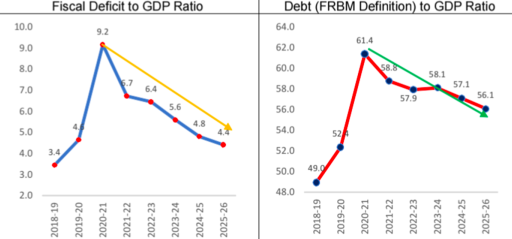Syllabus: GS3/ Economy
Context
- The central government has announced a shift towards the “debt-GDP ratio” as the fiscal anchor, beginning from the 2026-27 financial year.
About
- The government has detailed three levels of fiscal consolidation based on nominal GDP growth assumptions:
- Mild: 10% growth rate
- Moderate: 10.5% growth rate
- High: 11% growth rate
- Debt-GDP ratio in India: For the central government, the ratio is estimated to be 57.1% in 2024-25 and 56.1% in 2025-26.
- The government aims to reduce the debt-GDP ratio to 50±1 per cent by 2031.

Rationale Behind the Shift
- Enhanced Transparency and Flexibility: Unlike rigid annual fiscal deficit targets, the debt-GDP ratio provides a more comprehensive and long-term perspective of fiscal health.
- Alignment with Global Best Practices: Many advanced economies prioritize debt sustainability over annual deficit targets, ensuring that fiscal policies remain adaptable to changing economic conditions.
- Better Fiscal Management: This approach allows governments to rebuild financial buffers and allocate resources efficiently for growth-enhancing expenditures.
- Disclosure of Off-Budget Borrowings: The new approach aims to bring greater clarity and transparency in government borrowings, addressing past concerns about fiscal opacity.
Challenges
- FRBM Act Compliance: The new framework suggests a significant delay in achieving the Fiscal Responsibility and Budget Management (FRBM) Act target of 40% debt-GDP ratio.
- Implementation Challenges: Maintaining fiscal discipline while ensuring adequate public expenditure for economic growth remains a challenge.
- State Debt Burden: The total debt burden, including states, remains a concern, necessitating coordinated fiscal consolidation.
Concluding remarks
- The shift to the debt-GDP ratio as a fiscal anchor marks a significant change in India’s fiscal policy framework.
- While it offers greater flexibility and long-term sustainability, effective implementation and adherence to fiscal discipline will be crucial in achieving the targeted fiscal consolidation.
| NK Singh committee recommendation – Debt to GDP ratio: The Committee suggested using debt as the primary target for fiscal policy. A debt to GDP ratio of 60% should be targeted with a 40% limit for the center and 20% limit for the states by FY23. – The fiscal deficit to GDP ratio of 2.5% by FY23. – Fiscal Council: The Committee proposed to create an autonomous Fiscal Council with a Chairperson and two members appointed by the center. The role of the Council would include: 1. Preparing multi-year fiscal forecasts, 2. Recommending changes to the fiscal strategy, 3. Improving quality of fiscal data, 4. Advising the government if conditions exist to deviate from the fiscal target. – Deviations: The Committee suggested that grounds in which the government can deviate from the targets should be clearly specified, and the government should not be allowed to notify other circumstances. – Debt trajectory for individual states: The Committee recommended that the Finance Commission should be asked to recommend the debt trajectory for individual states. |
Source: IE
Previous article
US Withdrawal from UNHRC, WHO, and Other International Forums
Next article
News In Short 6-2-2025